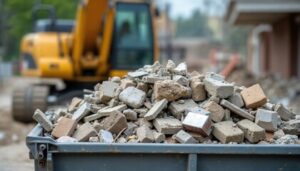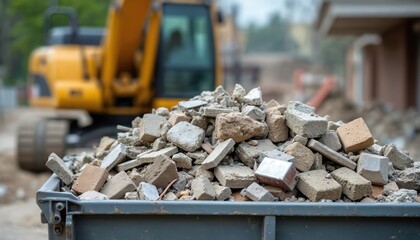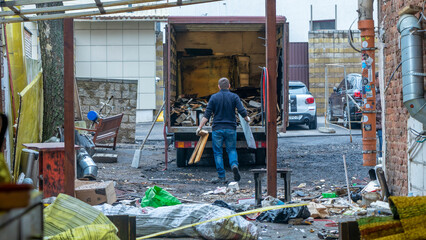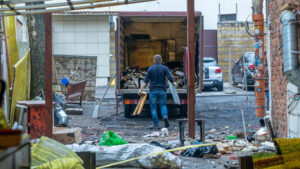Debris removal is the process of clearing and disposing of waste. It can be used in a variety of situations, including after natural disasters and construction projects.
Private debris removal services can usually remove a wide variety of materials, including branches and other vegetation, household items, and construction materials. Many of these companies offer online scheduling for convenience. Visit https://www.alwaysrecoveringjunk.com to learn more.
There are a number of different methods for debris removal. The best method for a particular project depends on the type of debris and its location, as well as any potential hazards. Some types of debris may be too dangerous to handle by hand, while others may require specialized equipment. Some common debris removal tools include rakes, shovels, and trash trays. Other tools, such as blowers, vacuums, and chainsaws, can be used to clear large areas of debris quickly and efficiently. For larger projects, specialized equipment such as bulldozers and excavators may be necessary.
In addition to removing debris, some projects also involve recycling or disposing of the waste materials. This process involves separating recyclable materials from non-recyclable ones, and identifying a facility that can accept the material for proper disposal. It is also important to follow any safety protocols that are applicable to the type of debris being removed.
For some types of debris, such as hazardous waste, the removal process can be more complicated. This may require a team of professionals who are trained in the safe removal and handling of these materials. In such cases, the debris must be removed in a controlled environment where there are no fire hazards.
During the debris removal process, it is important to monitor progress and make adjustments as needed. This may include revising the timeline, reallocating resources, or adjusting the order of work. In addition, it is essential to use the correct equipment for the job, and to ensure that all workers are using proper safety protocol.
Debris removal is an important service that helps to keep our communities clean and safe. It can be used in a variety of situations, from natural disasters to construction projects. In most cases, professional services are available to remove and dispose of the debris. These services can help to reduce the risk of injury and damage, and ensure that the debris is disposed of in a timely manner. They can also provide advice and guidance on the most efficient way to handle the debris removal process.
Debris Removal in the Aftermath of a Natural Disaster
During and after natural disasters, debris removal is an essential part of clean-up efforts. In addition to clearing away the damage from a storm, it allows emergency responders to access areas that may be unsafe and makes it easier for people in the area to get the help they need.
Debris that is generated by a natural disaster often includes hazardous materials, structural remnants of buildings, and personal belongings that have been damaged or lost. This type of debris requires specialized handling and disposal procedures to ensure environmental safety.
Hurricanes, tornadoes, fires, and floods all create large amounts of debris that must be cleared to restore normal conditions and facilitate recovery. The large volumes of waste can overwhelm local garbage disposal systems and force communities to use alternative methods for dealing with the waste.
The most common form of debris removal in the aftermath of a natural disaster is burning the debris, which helps to reduce the volume and speed up the cleanup process. However, this method of debris removal can pose health and safety concerns, so it must be conducted in accordance with federal, state, and local regulations.
In addition to burning debris, other options for debris removal in the aftermath of a natural emergency include landfills and incinerators. However, these methods can produce toxic gases and other environmental hazards that must be handled carefully.
Private citizens can also play a role in debris removal after a natural disaster, particularly if they have the right equipment and training. For example, homeowners can remove white goods (washers, dryers, and refrigerators) from their homes following a disaster. They can also participate in cleanup efforts by assisting with clean-up projects and helping to clear roads and public spaces. Many home insurance settlements and volunteer organizations provide assistance with debris removal after a disaster.
Government agencies can help with the debris removal process by providing funding, guidance, and manpower. In some cases, these agencies can also coordinate the effort with other federal, state, and local entities. The Federal Emergency Management Agency is the primary agency involved in coordinating disaster debris removal, but other agencies may provide assistance and support as needed.
Debris Removal in Routine Maintenance
Debris removal is often part of regular roadway maintenance. When this happens, it is critical to keep traffic moving safely around the site. Effective communication and dynamic lane strategies are essential. Traffic management systems like those offered by J-Tech can automatically alert drivers to changing conditions, reducing the need for manual lane changes and minimizing congestion. Traffic signaling systems that display real-time lane usage are also important, as they help drivers plan their routes and avoid delays.
Efficient debris cleanup requires thorough site assessments, prioritization of clean-up activities, and proper methods and equipment. In addition, effective coordination and collaboration with local traffic authorities is crucial for achieving efficient roadway operations.
Keeping the public informed about roadway work helps reduce traffic disruption and maintains trust in government agencies. This can be achieved through regular press releases and social media updates. Dedicated email and text messaging channels can also be established to provide information quickly and effectively. Additionally, signage that outlines lane closures or restrictions should be placed at every roadway work site, and all staff should wear high-visibility clothing and clearly mark their roles and responsibilities.
A well-coordinated approach to roadwork minimizes disruption and improves safety for workers and motorists alike. By bringing traffic control, scene stabilization, and incident maintenance response under a single command center, agency leadership can streamline operations, improve efficiency, and enhance overall roadway safety.
While demolition and debris removal may seem similar, there are significant differences in their functions. Demolition is the intentional destruction or dismantling of structures, while debris removal involves the collection and disposal of waste material that results from a construction or demolition activity. Both are essential for maintaining a safe environment, but their approaches to removing debris are very different.
A key aspect of debris removal is ensuring that only eligible debris is collected and that it is processed, stored, and removed in compliance with state regulations. Detailed records should be kept to ensure that contractors are not artificially loading trucks to maximize reimbursement. In addition, unannounced inspections should be conducted to verify that all loads meet criteria for eligibility, and hazardous trees are not being cut without authorization.
Debris Removal in Construction
Debris removal is a necessary part of construction and renovation projects. Cluttered sites can be a fire hazard, lead to worker injury, and interfere with productivity. Efficient debris management can mitigate these hazards and ensure adherence to environmental regulations.
Sorting and disposing of construction waste requires specialized knowledge and equipment. The complexity of a project dictates the type and quantity of debris generated, as well as the most appropriate disposal method.
On-site disposal may involve recycling or landfilling, depending on the materials involved. Typically, wood and metal debris can be recycled or reused, while other materials must be disposed of in a designated landfill or waste management facility. In addition, some types of debris must be handled with special care due to their toxic nature, such as asbestos, lead paint, and contaminated soil.
One common method of debris removal on construction sites is to rent a dumpster for the duration of the project. This can be done by calling a junk removal service, who will deliver the dumpster to the site and collect it when the job is complete. Some larger projects may require a bobcat or excavator to pick up large pieces and load them into the dumpster.
Another option is to use a debris chute. This is a long tube placed on the side of a building. Workers can throw debris into the chute, where it slides down into a dumpster or truck below. Other on-site disposal options include trash trays and debris lifts, which allow workers to quickly remove small debris items such as nails and screws.
Proper storage and disposal of construction debris is essential to minimize environmental impact and comply with local, state, and federal laws and regulations. Illegal dumping of debris can cause pollution, which can have significant impacts on ecosystems and public health.
While it’s possible to remove debris from a construction or renovation project on your own, the time and safety risks associated with hauling and disposing of large amounts of debris make this a task best left to professionals. A debris removal company can provide a cost-effective solution, and their expertise allows crews to focus on the project at hand.


